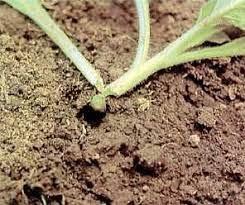Article by Laura Mcleod, Vancouver Island Master Gardeners Association
Question:
What pest is eating my veggies?
Each spring, we hear from vegetable gardeners who are frustrated when they find their seedlings mowed down by an unknown culprit, or ragged holes in their leaves. There are two common culprits: cutworms and cabbage worms. Here is how to tell the difference.
Cutworm Damage

Identification
If the seedling is ‘cut off’ near the base, the cutworm is the culprit. Cutworms are caterpillars (moth larvae). They hide under leaf litter or soil during the day, and come out at night to feed on plants. The larva typically attacks the first part of the plant it encounters, namely the stem. It literally ‘cuts it down’, hence the name.
Cutworms are rarely seen since they feed at night. They come in a variety of colours. However, they are generally no more than 2 inches (5 cm.) long and if you pick them up, they curl into a C shape.
Cutworms are general feeders that eat a wide range of plants. Common vegetables they like to feed on include asparagus, beans, cabbage and other crucifers, carrots, celery, corn, lettuce, peas, peppers, potatoes and tomatoes. A few species feed on turfgrass. Cutworm damage is only an issue when a seedling is very young and tender.
Prevention
- Fashion a four-inch ‘collar’ for the base of the young seedling. You can use a tuna can, part of a toilet paper roll, or something similar.
- Cutworms dig down into the soil to hide. If you are gardening and find a C shaped cutworm, remove it from the garden bed and leave it for the birds to eat.
- Bee flies, parasitic wasps, ground beetles and birds all help keep cutworm populations down. Ensure your garden has sufficient diversity to support these populations.
Cabbage Worm Damage

Identification
Holes that are in the leaves are typically caused by cabbage worms, which are the larvae of the cabbage butterfly (the white butterfly you commonly see flitting around your garden; it is not native to North America. A bit of cabbage worm damage won’t harm the plant and is mostly cosmetic. But if you get a large population, it can kill the plant by removing so much of the leaf area that photosynthesis can’t occur.
This is a common pest for cruciferous vegetables (i.e., cabbage, kale, cauliflower, broccoli, etc). To confirm, inspect the underside of the leaves regularly. If you see green caterpillars or tiny white/yellow eggs that are individually laid, squish them or drop into water. You may also see their tiny eggs (they look like little white or yellow dots) on the leaf which also should be wiped away.
Prevention:
- In the spring/summer, using floating row cover can help prevent the white cabbage butterflies from landing on the plants and laying eggs.
- Avoid having your cruciferous vegetables all in one place and try to intersperse them around your garden area.
- Maintain a grass-free and weed-free zone around the garden to keep cutworms from migrating in from the neighboring lawn.
- You can try planting nasturtiums around the base of cruciferous vegetable crops to serve as a ‘trap crop’. However, be sure to periodically remove infested trap crop plants to prevent a booming population of cabbage moths in your garden.
- Some folks report that planting fragrant herbs like dill, rosemary and oregano, or marigolds, will repel cabbage butterflies.
For gardening questions in the growing season, contact the Gardening Advice Line.

